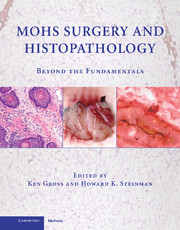Book contents
- Frontmatter
- Contents
- CONTRIBUTORS
- MOHS SURGERY AND HISTOPATHOLOGY
- PART I MICROSCOPY AND TISSUE PREPARATION
- PART II INTRODUCTION TO LABORATORY TECHNIQUES
- PART III MICROANATOMY AND NEOPLASTIC DISEASE
- Chap. 11 NORMAL MICROANATOMY: VERTICAL AND HORIZONTAL
- Chap. 12 BASAL CELL CARCINOMA: VERTICAL AND HORIZONTAL
- Chap. 13 SQUAMOUS CELL CARCINOMA: VERTICAL AND HORIZONTAL
- Chap. 14 UNUSUAL TUMORS: VERTICAL AND HORIZONTAL
- Chap. 15 MOHS FOR MELANOMA
- Chap. 16 TAKING STAGES BEYOND STAGE I
- Chap. 17 PERINEURAL TUMORS
- PART IV SPECIAL TECHNIQUES AND STAINS
- INDEX
Chap. 16 - TAKING STAGES BEYOND STAGE I
from PART III - MICROANATOMY AND NEOPLASTIC DISEASE
Published online by Cambridge University Press: 03 March 2010
- Frontmatter
- Contents
- CONTRIBUTORS
- MOHS SURGERY AND HISTOPATHOLOGY
- PART I MICROSCOPY AND TISSUE PREPARATION
- PART II INTRODUCTION TO LABORATORY TECHNIQUES
- PART III MICROANATOMY AND NEOPLASTIC DISEASE
- Chap. 11 NORMAL MICROANATOMY: VERTICAL AND HORIZONTAL
- Chap. 12 BASAL CELL CARCINOMA: VERTICAL AND HORIZONTAL
- Chap. 13 SQUAMOUS CELL CARCINOMA: VERTICAL AND HORIZONTAL
- Chap. 14 UNUSUAL TUMORS: VERTICAL AND HORIZONTAL
- Chap. 15 MOHS FOR MELANOMA
- Chap. 16 TAKING STAGES BEYOND STAGE I
- Chap. 17 PERINEURAL TUMORS
- PART IV SPECIAL TECHNIQUES AND STAINS
- INDEX
Summary
THE HIGH CURE rate of Mohs surgery rests on one word: accuracy. A Mohs surgeon must be accurate in frozen section diagnosis and mapping tumor location. Once tumor is noted and mapped in stage I, additional layers/stages are taken in the positive areas until negative margins are obtained. Failure in this latter step will undermine the cure rate and tissue-sparing benefits of Mohs surgery. Errors are especially likely in situations that involve multiple sites, multiple stages, difficult tumors, and convoluted anatomic areas. Before touching the scalpel, a number of questions must be addressed. It is the purpose of this chapter to present a systematic approach for minimizing errors in Mohs surgery beyond stage I. The ensuing discussion assumes that in stage I, there is correct orientation, complete tissue integrity (entire epidermis present, deep tissue present without gaps, inked margins present), adequate staining, and thin sections.
DO I HAVE THE CORRECT MOHS MAP?
Wrong site, wrong patient, and wrong surgery are all sentinel errors that harm patients. Correct patient and correct site are fundamental obligations of all Mohs surgeons. For severely actinically damaged patients, identifying the correct biopsy site is a challenge unless photographs are used with measurements from indelible anatomic landmarks. Mohs maps must contain several identifiers: patient's full name, date of birth, medical record number (unique to that practice), and unique Mohs case number. Patients with the same last names should not be scheduled for Mohs on the same day, if at all possible.
- Type
- Chapter
- Information
- Mohs Surgery and HistopathologyBeyond the Fundamentals, pp. 138 - 141Publisher: Cambridge University PressPrint publication year: 2009



